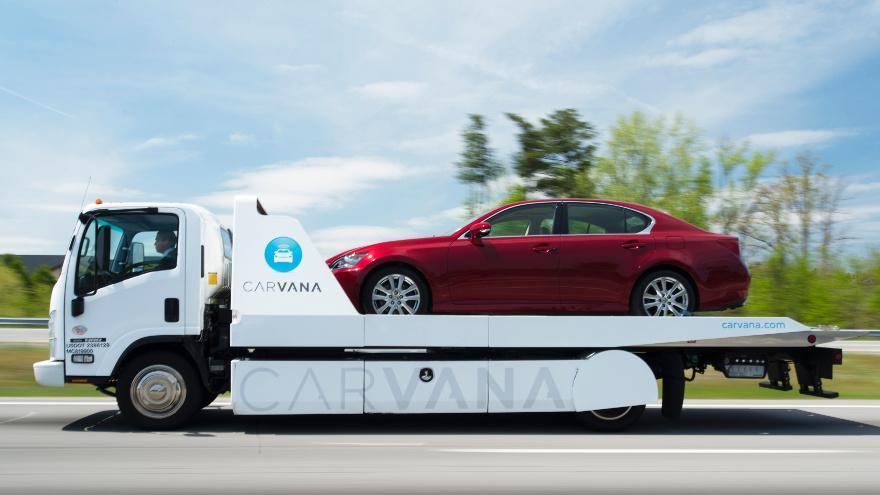The announcements regarding Carvana’s growth just keep on coming.
The e-commerce platform came out with the news in February that it opened in its 100th market— in Savannah, Ga. — as well as in five Northeast markets. Prior, in January, it announced it was launching in five New York markets and in Columbus, Ga.
Carvana’s latest expansion announcement came on Tuesday as the company launched in its third market in Arizona: the Prescott area.
With the Prescott launch, Carvana now offers as-soon-as-next-day vehicle delivery in 101 markets across the United States. The company was founded in 2012 and is based in Phoenix.
Carvana founder and chief executive officer Ernie Garcia said in a news release that the latest Prescott move was particularly meaningful, since it is in the company’s home state of Arizona.
“We look forward to bringing Prescott the new way to buy a car and all of the convenience and selection that offers area car buyers,” Garcia said.
Lyft vehicles might range from four-cylinder compacts to eight-cylinder full-size SUVs. But now fueling all of its technology infrastructure is Amazon’s cloud.
Amazon Web Services recently announced that ride-sharing company Lyft is “all in” for using its cloud services, which includes database, serverless, machine learning, and analytics. Lyft will use those services to automate and improve on-demand, multimodal transportation for riders and also to increase its autonomous vehicles business.
Lyft has used the cloud since its inception, with cloud company Amazon Web Services powering Lyft’s on-demand transportation platform. The platform provides more than 50 million rides a month. Lyft runs its operations, which provides a multimodal platform for drivers and riders in the U.S. and Canada, as well as backend platform systems, financial applications, and website on AWS.
AWS’s more than 165 fully featured services include compute, storage, databases, networking, analytics, robotics, machine learning and artificial intelligence (AI), Internet of Things (IoT), mobile, security, hybrid, virtual and augmented reality (VR and AR), media, and application development, deployment, and management.
Lyft says it is going all-in on AWS to enhance its ridesharing marketplace, which it says is available to about 95 percent of the U.S. population and in select Canadian cities. The company says the move will help grow its bike and scooters businesses, and power its self-driving technology.
AWS notes that Lyft’s move to run on AWS’s helps support Lyft’s everyday business and scales easily for peak periods. Demand can greatly increase on weekends and holidays. Lyft also relies on an Amazon database, Amazon DynamoDB, which AWS says delivers high performance at scale, to support areas such as a ride-tracking system allowing the company to provide more precise vehicle routing.
Lyft has used Amazon DynamoDB, Amazon Elastic Container Service for Kubernetes (Amazon EKS) and AWS Lambda. By using those services, Lyft migrated to a microservices architecture to create more than 150 microservices that independently scale workloads. They also reduce complexity in the cloud to “enhance every element of the rider experience,” Amazon stated in a news release.
Lyft also has a data lake on Amazon Simple Storage Service (Amazon S3). Using Amazon Redshift, Lyft analyzes its vast amount of cloud data, providing insights on riding patterns and predicting pick-up and drop-off locations. That technology supported the introduction of Lyft Line, the company’s Shared ride service.
Seeking to use machine learning services such as Amazon SageMaker, Lyft is looking to help provide fare estimates, enable fraud detection, and improve on pick-up and drop-off spots That will help Lyft build a cost-effective and reliable self-driving system for ridesharing, according to Amazon.
“We built our business on AWS from the very beginning, taking advantage of their extensive compute power, depth and breadth of services, and expertise to develop an effective cloud infrastructure to support our growing business and goal of improving people’s lives with transportation,” Lyft chief technology officer Chris Lambert, chief technology officer said in a news release.
“By operating on AWS, we are able to scale and innovate quickly to provide new features and improvements to our services and deliver exceptional transportation experiences to our growing community of Lyft riders," Lambert continued.
"With AWS, we don’t have to focus on the undifferentiated heavy lifting of managing our infrastructure, and can concentrate instead on developing and improving services with the goal of providing the best transportation experiences for riders and drivers, and take advantage of the opportunity for Lyft to develop best-in-class self-driving technology," Lambert went on to say.
Groupe PSA describes Peugeot as “an iconic, two-centuries-old brand.” With that in mind, the company has named Peugeot as its chosen brand in its move back into the North American market.
The company stated that Groupe PSA will market Peugeot on five continents when it introduces the brand in North America. Groupe PSA further describes Peugeot as a global brand that has seen strong growth and profitability in recent years, which the company notes as a reason that “Peugeot is ideally suited for the North American market.”
This decision is part of a 10-year plan that Groupe PSA announced in 2016 for a North American entry. The company says the plan will “incorporate a range of services and products focused on customer satisfaction.”
That North American entry started when the company in late 2018 introduced its Free2Move carsharing service. The service employs more than 500 vehicles as part of Groupe PSA’s Free2Move brand that provides mobility services with 65,000 vehicles in 12 countries.
“Our decision to bring Peugeot back into North America is the culmination of several years of study and research aimed at which of Groupe PSA’s brands would best serve the customer needs of this market,” Groupe PSA North America president and chief executive officer Larry Dominique said in a news release. “We are taking a pragmatic approach to entering the North American market and are confident that, from the larger ‘mobility services’ revolution currently taking place, to the more fundamental models of retail, service, financing and logistics — we’ll continue to build our plan on careful, scalable solutions.”
Jean-Philippe Imparato, Peugeot brand chief executive officer, added, “With more than 208 years of history, including two early victories of the Indianapolis 500, Peugeot’s international adventure continues with new territories and new challenges. Our clear positioning as the best high-end generalist brand is based on a solid and coherent strategy, which all the teams are eager and proud to bring to the North American customers, with this promise always kept and renewed, to include Peugeot’s excellence, allure and emotion in each of our cars.”
It’s one of life’s greatest frustrations: Finding a place to park. Making the problem even more frustrating is the fact that many businesses, including car dealers, have under-utilized parking spaces available.
A new app promises to help solve that problem.
Parkedit.Space is designed to connect owners of underutilized parking spaces with drivers and auto dealers facing the agony of a lack of parking. Through the platform, private individuals and businesses can find parking spaces around town quickly through what the company describes as an uncluttered user interface.
The company notes that auto dealers are often at one extreme or the other, with too much underutilized parking or none, and they struggle to locate legal places to park. The Parkedit.Space app connects these parties in seamless, secure manner, according to the company.
“The concept allows those with extra space to monetize what they have, and those in need of space to quickly and easily reserve parking while saving time and money.” Parkedit.Space chief executive officer Daniel Marzouk said in a news release.
Parkedit.Space is a member of the New York Independent Automobile Dealers Association, and a leader of that organization said its dealers continue to seek relief from the stress of parking.
“Dealers’ parking needs change daily. Parkedit.Space is a lifesaver for our dealers," said NYIADA executive director Paula Frendel.
Upfront price is the most important priority for U.S. and European consumers when buying a new vehicle. For Chinese consumers, however, ride and handling are most important.
That is according to a new report from market intelligence and consulting company, Strategy Analytics.
For younger age groups, however, safety and infotainment features have been rising in importance as they begin the search for a new vehicle. Their interest in autonomous features is also increasing.
For respondents in the United States, Western Europe, and China, the top five most important factors are upfront price, fuel efficiency, ride/handling, and workmanship/visual appeal.
Although upfront price was the most important priority for U.S. and European consumers, the importance of upfront price and fuel efficiency fell across all regions.
The importance of automated driving features showed an increase for all regions.
Strategy Analytics director of syndicated research, UXIP and report author Chris Schreiner said in a news release that the consistent de-emphasis on upfront price and fuel efficiency in the vehicle purchase decision was a key trend in the research.
“This could be a general trend, but it is also likely that a strong global economy over the past few years combined with more fuel-efficient vehicles has placed less importance on these factors,” Schreiner said.
But Schreiner added that in the United States and Europe, upfront cost remains the most important feature. Cost is also the most important factor for current premium vehicle owners in the United States.
Schreiner notes, however, that the U.S./China trade wars, along with the impact of Brexit, could bring about a downturn in the global economy, which could reverse the upfront cost trend in 2019.
Strategy Analytics vice president, UXIP Kevin Nolan said in a news release that vehicle purchase priorities in China are much different because of the different demographics of new vehicle owners.
“In general, younger consumers are placing relatively more emphasis on vehicle features and UX than others,” he said. “Given the average age of new car buyers, this is of considerable importance today for China, and will be a future trend to watch in the West.”
Carvana continues to expand its reach as an e-commerce platform for buying and selling used cars.
After its announcement in January that it launched in five New York markets and that it also began operations in Columbus, Ga., Carvana announced on Wednesday that it has launched in five additional Northeast markets.
Carvana customers can shop for vehicles on Carvana.com, and they can finance, purchase, or sell their current vehicle to Carvana. Now, area residents can schedule as-soon-as-next-day delivery in Westchester County, N.Y.; Barnstable, Mass.; Norwich, Conn.; Atlantic City, N.J.; and Trenton, N.J.
With Wednesday’s launch, Carvana now offers as-soon-as-next-day vehicle delivery in 96 markets across the United States.
“As we grow our presence in the Northeast, we’re delivering the convenience and savings those customers are looking for when buying their next vehicle,” Carvana founder and chief executive officer Ernie Garcia said in a news release.
“We’re looking forward to bringing the new way to buy a car to Westchester, Barnstable, Norwich, Atlantic City and Trenton with as-soon-as-next-day delivery," Garcia added.
For decades, Japanese-brand automakers have made investments in the U.S. economy and U.S. workforce. That commitment has paid off for U.S. workers.
According to an employment study that Rutgers University economics professor Thomas Prusa prepared for the Japan Automobile Manufacturers Association’s U.S. office, those Japanese automakers generate 1.52 million jobs throughout the United States.
The study, titled, “The Contribution of the Japanese-Brand Automakers to the United States Economy,” shows continued nationwide growth in direct, dealer network, intermediate and spin-off employment.
As of late 2017, according to the report, Japanese-brand automakers directly employed more than 92,000 workers. Also, their dealer network employed more than 355,000 workers.
“In addition to their direct and dealer employment, these companies support approximately 250,000 jobs in the U.S. automotive supplier network, actively strengthening the American manufacturing base,” Prusa said in a news release.
Other notable numbers from the report:
— More than 781,000 U.S. jobs are generated by the Japanese-brand automobile companies’ U.S. production facilities, R&D centers and headquarters.
— More than 738,000 U.S. jobs are generated by the Japanese-brand automobile companies’ dealer network.
— The contribution of 1.52 million private sector U.S. jobs makes Japanese-brand automobile companies among the largest job creators in the United States.
— Total annual compensation from the jobs that Japanese-brand automobile companies create in the United States is more than $109 billion.
— Personal income taxes from these jobs are almost nearly $16 billion, the study estimates.
Manny Manriquez, general director of the Japan Automobile Manufacturers Association’s U.S. office, noted in a news release that Japanese-brand automakers' cumulative direct U.S. employment has risen by almost 28 percent since 2011. That is much higher than the 6-percent growth rate in overall U.S. manufacturing employment over the same time period, Manriquez noted.
Manriquez urged leaders in Washington, D.C. to keep those numbers in mind as they consider trade policies affecting the American auto industry.
Speaking of which, several dealer organizations have voiced on similar trade matters. More on that here.
“Two wheels. One planet. Zero emissions.”
That is the motto for Silicon Valley-based electric personal mobility startup GenZe. The company started out in 2012, developing IoT-connected electric scooters and bicycles in Fremont, Calif.
GenZe says that since then, it has become a key supplier within the shared mobility category, launching fleet electric bikes and scooters with public operators as well as fleets in the tourism, delivery, college and corporate sectors.
On Monday, GenZe announced it joined the North American automotive division of automotive engineering company, Mahindra Group. The companies say the acquisition reflects the personal transportation industry’s rapidly changing landscape in 2019.
That changing landscape includes bikeshare acquisitions by Uber, Lyft, and Ford Motor Co.
“Mobility is rapidly evolving and we’re adapting to these changes to stay at the forefront of personal transportation,” Rick Haas, chief executive officer of Mahindra Automotive North America, said in a news release. “Ultimately, we are a mobility business and we see GenZe as a great addition to our growing portfolio of purpose-designed transportation solutions.”
The companies note that their partnership will combine Mahindra Automotive’s design, engineering, and manufacturing resources with GenZe’s expertise in the two-wheeled electric vehicle category.
GenZe started out with an initial product offering that featured a consumer e-Bike and what it describes as “the world’s first IoT e-Scooter featuring telematics.” The brand went on to offer a smartphone-connected electric bicycle.
Mahindra Automotive North America began operations in 2017, offering the Roxor off-road vehicle, which it says is creating a new subsegment in the “side X side” industry. The company says it is a finalist for the United States Postal Service replacement vehicle program.
“Micro-mobility — in the form of electric bikes and scooters — has become one of the fastest growing segments in transportation, as we work to provide ‘last-mile’ solutions within heavily congested cities,” Tom Valasek, GenZe chief commercial officer, said in a news release. “Joining Mahindra Automotive will give GenZe access to resources and scale. We can grow our platform of products faster and continue to build our connected digital offerings.”
When purchasing a vehicle, buyers would be wise to consider typical ownership costs to see the out-of-pocket expenses they will incur beyond the initial purchase price.
Kelley Blue Book took that into account in naming its 2019 5-Year Cost to Own Award winners, recognizing new vehicles with the lowest projected ownership costs.
Subaru and Lexus came out on top in the 5-Year-Cost-to-Own categories of brand, and luxury brand, respectively.
“Subaru’s key advantage is its high residual value, which lowers depreciation costs,” Eric Ibara, director of 5-Year Cost to Own for Kelley Blue Book, said in a news release. “Lexus offers consumers luxury vehicles at an affordable price and without expensive repairs down the road."
KBB’s 5-Year Cost to Own information considers factors such as depreciation, expected fuel costs, finance and insurance fees, maintenance and repair costs, and state fees.
“Our 5-Year Cost to Own information breaks down typical ownership costs, so shoppers can evaluate the out-of-pocket expenses they will incur beyond the initial purchase price,” Ibara said. “Consumers could save money down the road by choosing a vehicle that best fits their needs and their long-term budget.”
Following are KBB’s 5-Year Cost to Own Awards by vehicle category:
Compact car: Kia Soul
Mid-size car: Honda Accord
Full-size car: Chevrolet Impala
Entry-level luxury car: Acura ILX
Luxury car: Lexus GS
Mid-size SUV/Crossover—3 row: Mitsubishi Outlander
Full-size SUV/Crossover: Nissan Armada
Luxury subcompact crossover: Nissan Armada
Luxury subcompact SUV/crossover: Lexus UX
Luxury compact SUV/Crossover: Lexus NX
Luxury mid-size SUV/Crossover—2 row: Lexus RX
Luxury mid-size SUV/Crossover—3 row: Infiniti QX60
Luxury full-size SUV/Crossover: Infiniti QX80
Off-road SUV/Crossover: Jeep Wrangler
Mid-size pickup truck: Toyota Tacoma
Full-size pickup truck: Toyota Tundra
Minivan: Honda Odyssey
Sports car: FIAT 124 Spider
Hybrid/alternative energy car: Toyota Prius c
Electric vehicle: Nissan LEAF
Subcompact SUV crossover: Mazda CX-3
Compact SUV crossover: Subaru Crosstrek
Mid-size SUV/Crossover, 2 row: Hyundai Santa Fe
(2019 model-year vehicle's projected ownership costs are based on the average Kelley Blue Book 5-Year Cost to Own data for the initial five-year ownership period).
For more information about the 2019 5-Year Cost to Own Award winners, go to https://www.kbb.com/new-cars/5-year-cost-to-own-awards/.
Zubie, a connected-car platform and telematics data insights provider, says its end-to-end connected-car technology has delivered real-time information about vehicles and drivers since 2012 to help businesses manage and optimize their fleets.
Seeking to fuel growth in the fleet sector and to introduce new verticals with its connected-car products, the company noted on Thursday that it has closed a round of funding. Existing investors BP and Melody Capital are providing the capital infusion.
The company also announced that telecommunications veterans Paget Alves and Dennis Huber will join its board of directors. Alves and Huber have a combined 50-plus years of experience in telecommunications, finance, operations, marketing, product development, and IT.
Zubie did not disclose the amount of the funding in the news release.
“This investment in Zubie underscores the market need for an end-to-end connected car solution," Ron LeMay, chairman of the board for Zubie, said in a news release. “There are a lot of companies focused on data collection — and there’s a lot of data out there. The marketplace needs more companies that help organize the data and extract business insight, and that’s where Zubie fills a void. We’re thrilled with the perspectives Paget and Dennis will bring to the board.”
“With a more mature hardware market, the opportunity for differentiation is in delivering usable insights in a simple, reliable package,” Gary Tucker, chief executive officer of Zubie, said in a news release. “For Zubie, 2019 will be about improved usability of our existing insights and solutions in the fleet market, while addressing a need for real-time insight for rental businesses.”












